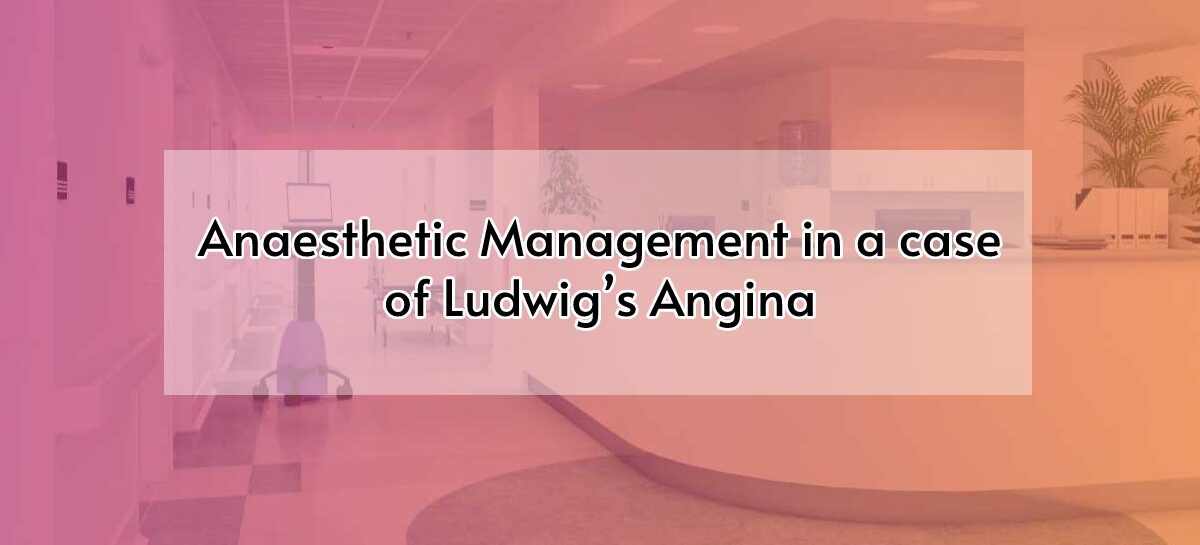INTRODUCTION:
Ludwig’s angina is a rare but potentially fatal condition mainly involving the submandibular & retropharyngeal spaces, characterized by a rapidly progressive inflammation & cellulitis of the soft tissues of the neck and floor of the mouth. The term “Ludwig’s angina” is a misnomer, as it is not related to angina pectoris or heart disease. It was first described by Wilhelm Fredrich von Ludwig, a German physician in 1836. The most life-threatening complication of Ludwig’s angina is airway obstruction. Prior to the development of antibiotics, mortality for Ludwig’s angina exceeded 50%. As a result of antibiotic therapy, along with improved imaging modalities and surgical techniques, mortality currently averages less than 10%.
CASE REPORT:
A 68 year old female patient came to the ER of our hospital with a complaint of severe pain & swelling involving the floor of the mouth extending into the submandibular region for the last 2 days. She had a history of difficulty in eating & mild hoarseness of voice for 1 day. There was no history of difficulty in breathing. On examination, there was a severely restricted mouth opening of just one finger breadth. She informed the doctors that there had been a dental extraction and was irregular with medication and follow up which was the cause for her poor glycemic control.
A clinical diagnosis of Ludwig’s angina was made & she was immediately shifted to the OT for emergency incision & drainage of the abscess under anaesthesia after getting high-risk consent.
ANAESTHETIC CONCERNS:
The main concerns in anaesthetising these patients are:
- Difficult mask ventilation due to swelling of the face & upper airway structures.
- Difficult intubation due to restricted mouth opening & edema of the pharyngeal soft tissues.
- Risk of bleeding & rupture of the abscess during intubation resulting in aspiration of blood & pus.
- Difficulty in extubation due to the persisting airway edema.
- Risk of stridor & respiratory failure in the postop period requiring re-intubation.
PLAN OF ANAESTHESIA:
The plan of anaesthesia was GA with controlled ventilation. Since the patient had a restricted mouth opening, it was decided to perform an awake fibreoptic bronchoscope (FOB) guided nasal intubation to maintain spontaneous breathing till the airway is secured.
CONCERNS DURING INTUBATION:
Even though intubation was planned under FOB guidance, there was a risk of failure to intubate due to the following reasons:
– Bleeding due to damage to the tissues caused while negotiating the scope.
– inability to visualise the cords due to peri-glottic edema
– Risk of sudden desaturation & hypoxia during the procedure due to aspiration, laryngospasm, etc.
For these reasons, all emergency airway equipment like laryngeal mask airay (LMA), ventilating bougie, needle cricothyrotomy set & tracheostomy tubes of various sizes were kept in the airway trolley.
An ENT surgeon was requested to be on standby as a backup in case an emergency surgical tracheostomy was needed. Consent for the emergency tracheostomy was obtained from the family pre-operatively.
PERI-OPERATIVE MANAGEMENT:
The steps of the procedure were clearly explained to the patient before shifting her to the OT. The patient was given a broad-spectrum antibiotic namely cefoperazone/sulbactam 1.5 gms iv & hydrocortisone 200 mg iv pre-operatively. The patient was premedicated with iv glycopyrollate 0.2 mg, midazolam 0.5 mg & fentanyl 50 mcg. After anesthetizing the upper airway using 10% lignocine spray and blocking the external branch of the superior laryngeal nerve & recurrent laryngeal nerve using 2% lignocine injection, the FOB was passed through the left nostril into the trachea. Once the carina was visible, a 6 mm endotracheal tube was railroaded over the scope & placed in the trachea. After bilateral air-entry was confirmed by auscultation & capnography, the patient was sedated with propofol 120mg & paralysed with cisatracurium 8mg. Anaesthesia was maintained with O2/ N2O 1:1 mixture with desflurane 4%. The abscess was drained intra & extra-orally by the maxillo-facial surgeon. The inter-operative period was uneventful.
Post-operatively, the patient was ventilated electively for 12 hrs in the ICU and extubated later once she was fully awake & airway edema had subsided.
DISCUSSION:
Etiology:
- The submandibular space is the primary site of infection in Ludwig’s angina. This space is divided by the mylohyoid muscle into the sublingual space superiorly & submaxillary space inferiorly.
- Almost 90% of the cases are caused by dental infections, primarily of the second and third molars teeth. The roots of these teeth penetrate the mylohyoid ridge so that any abscess or dental infection has direct access to the submaxillary space.
- Once an infection develops, it spreads contiguously to the sublingual space.
- Infection can also spread contiguously to involve the pharyngomaxillary and retropharyngeal spaces, thereby encircling the airway.
- Other rare causes include mandible fracture, neck trauma, tongue piercing, sialdenitis, neoplasm, and other parapharyngeal infections. Polymicrobial infection occurs in over 50% of cases. The most commonly cultured organisms include Staphylococcus, Streptococcus, and Bacteroides
Signs & Symptoms:
- The most common presenting symptom is dental pain or a recent history of dental procedures and neck swelling or neck pain.
- Dysphonia, dysphagia, and dysarthria may also be seen.
- Around 25-30% of patients present in respiratory distress with dyspnea, tachypnea, or stridor.
- Over 90% of patients have bilateral submandibular swelling and an elevated or protruding tongue.
Management:
- Broad-spectrum antibiotics like penicillins, clindamycin & metronidazole should be initiated early.
- Patients should be monitored closely for any signs & symptoms of airway compromise like dyspnea, tachypnea, dysphonia, stridor, etc
- Imaging techniques like contrast-enhanced CT scans of the neck help to identify those patients that are at risk of developing airway-related problems.
- There are currently no established guidelines for airway control in Ludwig’s angina. If signs of airway obstruction are present, immediate intubation to secure the airway is recommended.
- The airway may be secured by routine orotracheal intubation if there is adequate mouth opening & neck mobility. However, the best & safest method is by fibreoptic nasotracheal intubation. Blind nasal intubation is dangerous & should never be performed.
- More than 60% of the patients require a surgical procedure to drain the abscess.
CONCLUSION:
Ludwig’s angina is a medical emergency that needs urgent diagnosis & management with broad-spectrum antibiotics & close monitoring to watch for any airway obstruction. Once the signs of airway compromise like dyspnea, dysphagia or dyspnoea start to occur, it becomes a surgical emergency requiring urgent drainage to prevent catastrophic airway obstruction & potential threat to the life of the patient.

Dr Mohamed Najibullah
Consultant Anaesthesiologist & Intensivist,
Kauvery Hospital





